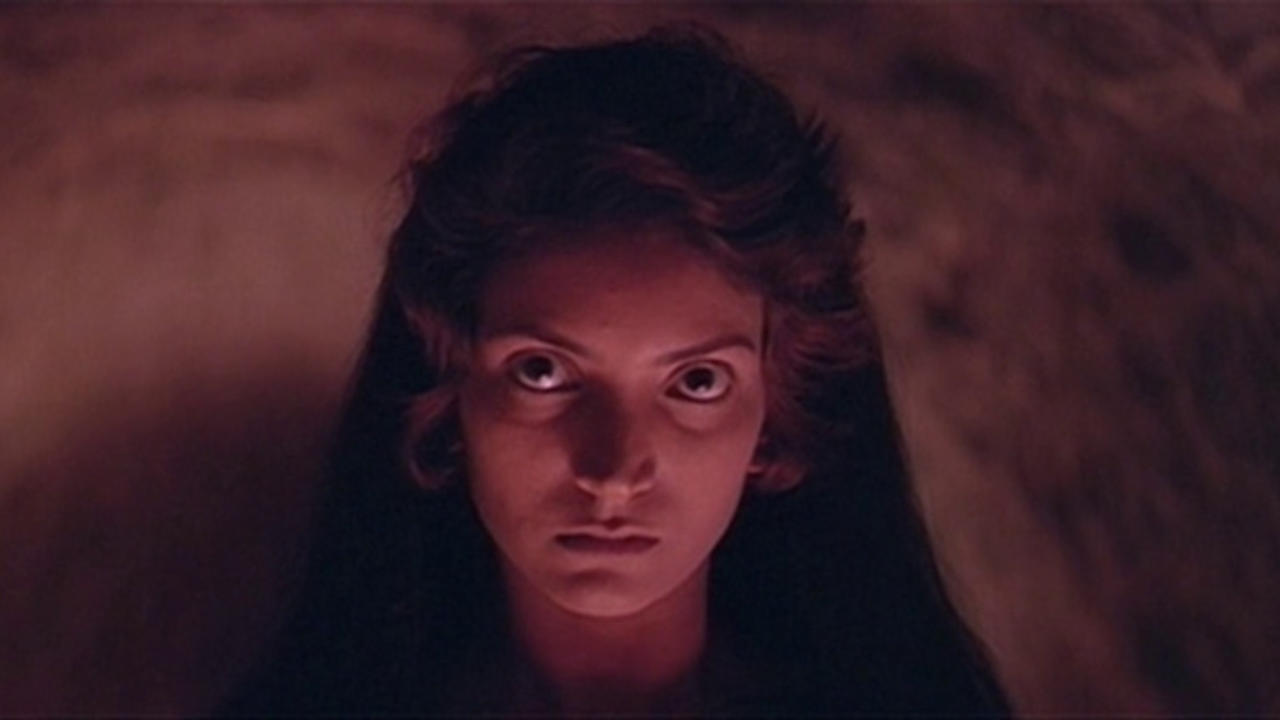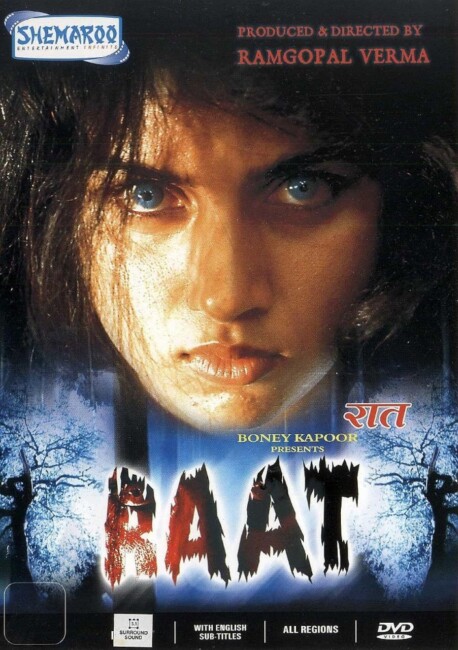Raat (Night)
Crew
Director/Screenplay – Ramgopal Varma, Dialogue – Virnay Shukla, Producer – Boney Kapoor, Photography – Teja, Music – Mani Sharma, Live Effects – Pamukumar, Special Effects – S.A. Aazim, M.A. Hafeez & Prasad Productions, Makeup – Chandra, Set Design – Thota Yadhur. Production Company – Varma Creations.
Cast
Revathi (Manisha ‘Mini’ Sharma), Rohini Hattangadi (Shalini Sharma), Akash Khurma (Desai Sharma), Kushant (Deepak), Om Puri (Sharji), Master Ateet (Bunty), Jaya Mathur (Rashmi), Anant Nag (Psychiatrist), C.V.L. (Narayan), Nirmalamma (Old Lady), Tej Sapru (Inspector)
Plot
University student Mini Sharma moves into a new house with her parents and young nephew Bunty. Mini is troubled by disturbing dreams. While she is out riding with Deepak, a boy from university, his motorcycle breaks down. He goes to town for a new tire, leaving her by the roadside. However, when he returns, she has changed and subsequently seems to go into intense trances. At a party, she snaps the neck of her best friend Rashmi while in a trance, and later attacks Deepak and her father. Her parents take her to a psychiatrist who places her in hospital but is baffled as to what the problem is. Her mother comes to the increasing conclusion that Mini is possessed by a malevolent spirit.
Director Ramgopal Varma (or Ram Gopal Varma as he is also known, even Ramgopal Verma as the DVD cover for Raat has him listed) is a prominent and acclaimed director within the Bollywood (Indian) film industry. Ramgopal Varma was a former video shop owner who first appeared with the highly successful and ultra-violent crime thriller Shiva (1990). Varma has gone on to make a number of successful films, including musical/romances like Rangeela (1995) and Mast (1999), the psychological thriller Kaun (1999) and numerous crime films like Satya (1998) and Company (2002). Ramgopal Varma is a prolific filmmaker and has been applauded as one of the leading lights of contemporary Indian cinema. Among other things, he bucked the Bollywood trend of including ubiquitous musical numbers in his films.
When it comes to the horror genre, you have to give Ramgopal Varma credit for trying. (Raat was only his third film). While Varma tries, Raat often seems like the fledgling efforts of an amateur filmmaker, one who keeps throwing things at his audience in the belief that sheer quantity of effect might produce results. You have to praise Varma for persistence but the end result ends up being so overwrought in terms of its perpetual straining for effect that it contrarily produces almost no effect at all. Varma continuously throws in jumps and sudden loud noises on the soundtrack – the loud blare of a blender, a scooter passing in front of the camera, the hiss of food being tossed into a wok, a tv coming on, the cut to a trumpet playing, a shriek laid over the soundtrack as young Master Ateet turns around holding a cat, or doors that creak with laughably loud and drawn out effect every time they are opened. It feels almost as though Raat is being directed by the sound effects department – the first half consists almost entirely of the attempts to create something scary solely via the soundtrack. In all cases, if one watched the abovementioned scenes with the sound turned off, there would be nothing even remotely scary to them.

At other times, it feels like Ramgopal Varma had just discovered the Steadicam – the opening credits, for instance, unusually feature a special credit just for the Steadicam operator (who is usually consigned to the end credits on a Hollywood film) – and was like a kid with a new toy. The opening is a thoroughly melodramatic dream sequence with Revathi running around a deserted town, stalked by ominous point-of-view camerawork just like The Evil Dead (1981), while obtrusively loud rock music plays on the soundtrack. There is so much of this constantly creeping point-of-view camerawork that one ends up getting sick of Varma’s Steadicam fifteen minutes into Raat.
Raat becomes okay once the schlock horror element emerges. There is the odd effective moment – the image that Varma has borrowed from Wes Craven of hands bursting through a wall to grab a sleeping person, and the scene where Revathi snaps her friend’s neck on a rooftop. Revathi also has an undeniable presence. Her performance in the last half consists of a series of intense stares out of eyes that are so pale that they are almost blue. She manages to conduct an unnerving transformation from average teenage girl to something sinister, which comes all in the way that she can let a spookily not-so-innocent smile slowly creep across her face. Om Puri, known from Western films like The Burning Season (1993), Wolf (1994) and My Son the Fanatic (1997), brings a degree of dignity and gravitas to the film when he enters in the last quarter, and the film mounts to a passably schlocky climax. That does mean that almost an hour of the 127-minute running time has consisted of little more than atmospheric padding, during which time very little actually happens. A much trimmer film would probably have cut all the creaking doors and Steadicam prowling and begun the story around about the time that Revathi is abandoned by the roadside.
Despite its two hour plus length, there is surprisingly little in the way of plot to Raat – we are told almost nothing about the woman whose spirit is possessing Revathi. There is no real explanation of why it was that Revathi became possessed, it is not even explained what happened when Deepak left her by the roadside and returned to find her glaring intensely. Of course, what Raat does eventually reveal itself as is a Bollywood version of The Exorcist (1973). (Indian cinema is renowned for outrightly stealing the plots of Hollywood hits and serving them up with a local flavour). We have the spirit of a murdered woman instead of a demon but the build-up about Revathi’s strange behaviour, her murder of others while possessed, the scenes taking her to doctors who puzzle over what is happening, to the entrance of a holy man exorcist – all follows the basic plotline of The Exorcist. Although, if anything, Raat is more down around the level of B-budget copies of The Exorcist like Abby (1974), Beyond the Door (1974) and The Antichrist/The Tempter (1974). Ramgopal Varma also later blatantly reworked The Exorcist in a further horror film Bhoot (2003), which has many similarities to Raat, although by that time Varma had polished his directorial skills considerably more, plus a sequel Bhoot Returns (2012).
Ramgopal Varma has also directed a number of other Bollywood horror films with the likes of:- the anthology Dana Zaroori Hai/You Must Be Scared (2006); the supernatural retribution film Darling (2007); the exorcism film Phoonk (2008); the monster movie Agyaat: The Unknown (2009); Ice Cream (2014) and Ice Cream 2 (2014); and the possession films 12 O’Clock (2021) and Deyyam (Dues) (2021).


